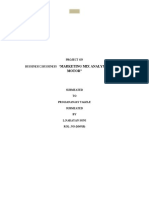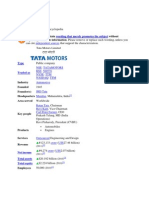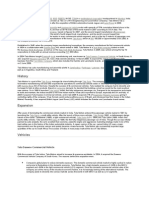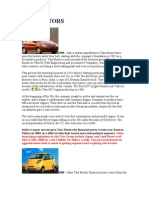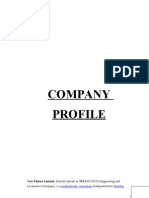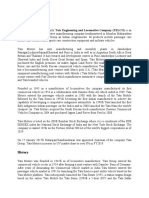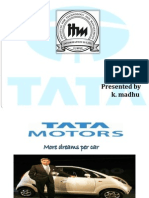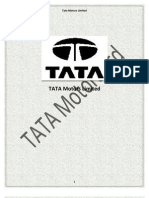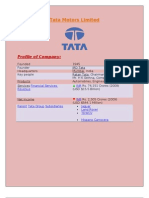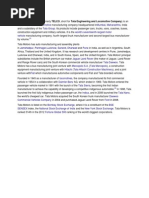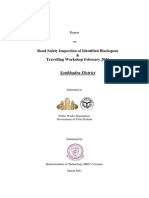History: Tata Indica
History: Tata Indica
Uploaded by
PoojaAggarwalCopyright:
Available Formats
History: Tata Indica
History: Tata Indica
Uploaded by
PoojaAggarwalOriginal Title
Copyright
Available Formats
Share this document
Did you find this document useful?
Is this content inappropriate?
Copyright:
Available Formats
History: Tata Indica
History: Tata Indica
Uploaded by
PoojaAggarwalCopyright:
Available Formats
History[edit]
The second-generation Tata Indica; one of the best selling cars in the history of the Indian automobile industry
The Tata Nano, the world's most affordable car
Tata entered the commercial vehicle sector in 1945 after forming a joint venture with Daimler-Benz of Germany. After
years of dominating the commercial vehicle market in India, Tata Motors entered the passenger vehicle market in 1991
by launching the Tata Sierra, a multi utility vehicle. Tata subsequently launched the Tata Estate (1992; a station
wagon design based on the earlier 'TataMobile' (1989), a light commercial vehicle), the Tata Sumo (1994; LCV) and the
Tata Safari (1998; India's first sports utility vehicle).
Tata launched the Indica in 1998, the first fully indigenous Indian passenger car. Although initially criticized by auto-
analysts, its excellent fuel economy, powerful engine and an aggressive marketing strategy made it one of the best
selling cars in the history of the Indian automobile industry. A newer version of the car, named Indica V2, was a major
improvement over the previous version and quickly became a mass-favourite. Tata Motors also successfully exported
large quantities of the car to South Africa. The success of Indica played a key role in the growth of Tata Motors.
[5]
In 2004 Tata Motors acquired Daewoo's South Korea-based truck manufacturing unit, Daewoo Commercial Vehicles
Company, later renamed Tata Daewoo.
[6]
On 27 September 2004, Tata Motors rang the opening bell at the New York Stock Exchange (NYSE) to mark the listing
of Tata Motors.
[7]
In 2005, Tata Motors acquired a 21% controlling stake in the Spanish bus and coach manufacturer Hispano
Carrocera.
[8]
Tata Motors continued its market area expansion through the introduction of new products such as buses
(Starbus & Globus, jointly developed with subsidiary Hispano Carrocera) and trucks (Novus, jointly developed with
subsidiary Tata Daewoo).
In 2006, Tata formed a joint venture with the Brazil-based Marcopolo, Tata Marcopolo Bus, to manufacture fully built
buses and coaches.
[9]
In 2008, Tata Motors acquired the British car maker Jaguar Land Rover, manufacturer of the Jaguar, Land Rover and
Daimler luxury car brands, from Ford Motor Company.
[10][11][12][13]
In May 2009 Tata unveiled the Tata World Truck range jointly developed with Tata Daewoo;
[14]
the range went in sale in
South Korea, South Africa, the SAARC countries and the Middle-East at the end of 2009.
[14]
Tata acquired full ownership of Hispano Carrocera in 2009.
[15]
In 2009, its Lucknow plant was awarded the "Best of all" Rajiv Gandhi National Quality Award.
[16]
In 2010, Tata Motors acquired an 80% stake in the Italian design and engineering company Trilix for 1.85 million. The
acquisition formed part of the company's plan to enhance its styling and design capabilities.
[17]
In 2012, Tata Motors announced it would invest around 6 billion in the development of Futuristic Infantry Combat
Vehicles in collaboration with DRDO.
[18]
In 2013, Tata Motors announced it will sell in India, the first vehicle in the world to run on compressed air (engines
designed by the French company MDI) and dubbed "Mini CAT".
On 26 January 2014, the Managing Director Karl Slym was found dead. He fell from the 22nd floor to the 4th floor of the
Shangri-La Hotel in Bangkok where he was to attend a meeting of Tata Motors Thailand.
[19]
You might also like
- Tatamotors Global Strategy International BusinessNo ratings yetTatamotors Global Strategy International Business20 pages
- Road (10.0m Width) Road (8.0m Width) Road (6.0m Width) CURBS & GUTTER (3647 L.M.)No ratings yetRoad (10.0m Width) Road (8.0m Width) Road (6.0m Width) CURBS & GUTTER (3647 L.M.)1 page
- National Car Test (NCT) Manual: Passenger Vehicles (Up To 8 Passengers and Less 3.5 Tonnes G.V.W.)No ratings yetNational Car Test (NCT) Manual: Passenger Vehicles (Up To 8 Passengers and Less 3.5 Tonnes G.V.W.)87 pages
- Tata Motors - Wikipedia, The Free Encyclopedia100% (1)Tata Motors - Wikipedia, The Free Encyclopedia15 pages
- Tata Motors Limited, Formerly Tata Engineering and Locomotive Company (TELCO), Is AnNo ratings yetTata Motors Limited, Formerly Tata Engineering and Locomotive Company (TELCO), Is An2 pages
- Tata Motors Limited (: NSE BSE Nyse Nasdaq Multinational Automotive Mumbai Tata GroupNo ratings yetTata Motors Limited (: NSE BSE Nyse Nasdaq Multinational Automotive Mumbai Tata Group15 pages
- Company Profile: Tata Motors Limited, Formerly Known As TELCO (TATA Engineering andNo ratings yetCompany Profile: Tata Motors Limited, Formerly Known As TELCO (TATA Engineering and51 pages
- Tata Motors: Jump To Navigationjump To Search100% (1)Tata Motors: Jump To Navigationjump To Search11 pages
- Introduction of Tata Motor: Public BSE: 500570100% (1)Introduction of Tata Motor: Public BSE: 5005703 pages
- Tata Motors Limited Is An Indian Multinational Automotive Manufacturing CompanyNo ratings yetTata Motors Limited Is An Indian Multinational Automotive Manufacturing Company1 page
- Tata Motors Limited (Formerly TELCO, Short For Tata Engineering and Locomotive Company) Is An IndianNo ratings yetTata Motors Limited (Formerly TELCO, Short For Tata Engineering and Locomotive Company) Is An Indian2 pages
- Corporate Story On Tata Motors Submitted by Group 2No ratings yetCorporate Story On Tata Motors Submitted by Group 217 pages
- Tata Motors: Assignment Product Design (Mec-25)No ratings yetTata Motors: Assignment Product Design (Mec-25)19 pages
- Project Work On TATA OF PERFORMANCE APPRAISALNo ratings yetProject Work On TATA OF PERFORMANCE APPRAISAL12 pages
- Tata Motors Limited (Formerly TELCO, Short For Tata Engineering and Locomotive Company) Is AnNo ratings yetTata Motors Limited (Formerly TELCO, Short For Tata Engineering and Locomotive Company) Is An1 page
- Jewels in the Crown: How Tata of India Transformed Britain's Jaguar and Land RoverFrom EverandJewels in the Crown: How Tata of India Transformed Britain's Jaguar and Land Rover5/5 (1)
- Chapter - 4 Data Analysis and Interpretation: Gender of RespondentNo ratings yetChapter - 4 Data Analysis and Interpretation: Gender of Respondent11 pages
- Saakshar Bharat Mission, Sirsa: Welcomes YouNo ratings yetSaakshar Bharat Mission, Sirsa: Welcomes You22 pages
- Birla Sun Life Insurance: Wealth Secure PlanNo ratings yetBirla Sun Life Insurance: Wealth Secure Plan20 pages
- Installation: SB-34 23. Remove Rear Seat Inner With Center Belt Assembly LHNo ratings yetInstallation: SB-34 23. Remove Rear Seat Inner With Center Belt Assembly LH3 pages
- Purdue Student Government: Recommendation 10-1 Against Jay Walking UpdateNo ratings yetPurdue Student Government: Recommendation 10-1 Against Jay Walking Update1 page
- Seetron TPMS Presentation Marketing Tools PDFNo ratings yetSeetron TPMS Presentation Marketing Tools PDF38 pages
- River Thames Scheme Scoping Report (2017)No ratings yetRiver Thames Scheme Scoping Report (2017)189 pages
- Appendix 4 Traffic Diversion Plan Registration Form (Sample Template)No ratings yetAppendix 4 Traffic Diversion Plan Registration Form (Sample Template)5 pages
- AIS-008-Installation of Lighting and SignallingNo ratings yetAIS-008-Installation of Lighting and Signalling80 pages
- As 2174.1-2006 Heavy Road Vehicles - Mechanical Coupling Between Prime Movers and Semitrailers - InterchangeaNo ratings yetAs 2174.1-2006 Heavy Road Vehicles - Mechanical Coupling Between Prime Movers and Semitrailers - Interchangea7 pages
















